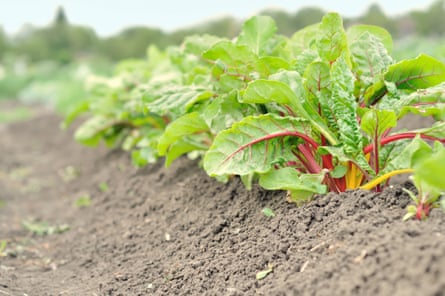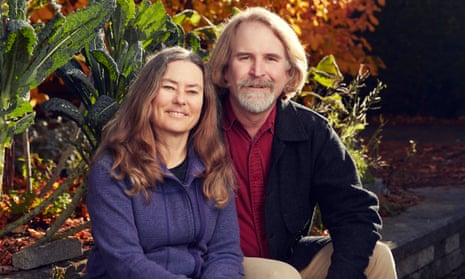Juicy is the best word to describe Anne Biklé and David Montgomery’s garden, even in the dying days of autumn. Emerald green, dewy grass; a vegetable patch where leafy kale stands tall and arugula nestles low; shrubs and trees – cork bark maple, Persian ironwood and wax myrtle – screening the area from passersby and a late-flowering rhododendron bearing plump red blooms.
It is this oasis that led them on a remarkable journey into another world, one that exists beneath our feet and is run by microbes, creatures invisible to the naked eye.
Their plan to create the garden in the barren backyard of their new house in north Seattle was nearly thwarted by the very thing that makes it so lush today: the soil. It had been wrecked by glacial till – small golf-ball-size rocks packed in hard clay left by glaciers thousand of years ago.
Biklé obsessively layered compost on the beds and to their surprise their new plants grew rapidly and abundantly. But Biklé’s background in biology and Montgomery’s in geomorphology meant they weren’t content to sit back and enjoy the fruits of their labour.
They were intrigued at the speed of the transformation and began poring over scientific papers to find out why. The more they found out about microbes and how they turned compost into a smörgåsbord of other nutrients for the growing plants, the more they rethought not only how they viewed soil but also – prompted by Biklé being diagnosed with cancer – human health, medicine and agriculture. Their mission of discovery is charted in a book they cowrote, The Hidden Half of Nature, out in the UK this week.
Looking out of the kitchen window at their labrador retriever, Loki, sniffing around the roots of a viburnum tree, Biklé says: “It all began 15 years ago. We’d bought this house and I had big-time garden lust. I had been going on garden tours, looking at books and dreaming of the day we’d do our own.”
They cleared the weed-riddled, stubby grass and concrete that was there when they moved in and bought thousands of dollars worth of plants, trees and shrubs. Biklé began to dig. “The first couple of holes went fine and then… aagh! It sounded like the metal shovel hitting concrete. I tried again and the same thing happened, then again and again. It was the quality of the soil. But the plants couldn’t sit around any longer, so they were going in. All we could do was address the soil from the top.”

Fertile soil needs a mix of weathered rock fragments and decaying organic matter. The former they had, it was the latter they lacked – in spades, many thousand of them. Commercial compost would blow their budget and Montgomery, still reeling from the smell of the chicken manure Biklé had used in the garden at their previous rented house, wanted a more fragrant solution.
Biklé, 55, a biologist and environmental planner, began gathering organic matter comprising woodchips from arborists, coffee grounds from baristas and leaves from neighbours’ lawns. She added a little “zoo doo” – faeces from grazing animals such as hippos and giraffes at the nearby zoo, which has little smell – and home-brewed compost tea from worm castings, kelp and molasses.
She said: “I’d tour around four or five Starbucks and fill up the car with 20 to 30 bags – they’re happy to give them to you. I’d mix them in with woodchips and leaves and layer it on the beds, about six inches thick. Gradually that would disappear, an eighth to a quarter of an inch every two weeks. We’d think: where did that go? The volume was decreasing so much and so quickly.”
Over the next few years they noticed the colour of the soil darkening to a rich chocolate brown and wildlife inhabiting the garden: first came worms and fat-bodied spiders, next bees and dragonflies as the plants burgeoned, and finally birds.
Montgomery, 54, a professor of geomorphology at the University of Washington and the winner of a $500,000 MacArthur Foundation “genius” award in 2008, says: “Anne was making soil far faster than nature could. We wanted to know how that was possible.”
Biklé adds: “I could understand a good part of that organic matter was being taken underground and broken down by beetles and insects, but when it got to the microscopic level, no. When we learnt about that, it was like, oh, there’s a hidden microbial world down there and it was fascinating.”
There are more microbes in a teaspoon of soil than there are people on the planet and they are everywhere, in water, air, earth, as well as inside our bodies and on our skin. Without them we couldn’t digest food, plants wouldn’t grow and there wouldn’t be enough oxygen for us to breathe. There are thought to be 2-3bn microbial species, divided into six groups: bacteria, viruses, fungi, protozoa, algae and archaea. They’ve had a bad press for much of the past century because some of them are nasty – the pathogens – and cause diseases such as TB, chickenpox and malaria, but most are harmless or helpful.
The husband and wife team was so amazed at the symbiotic relationship between microbes and plant roots that they initially decided to write a book on soil restoration. Plants can’t get the nutrition they need from soil without the help of microbes – particularly bacteria and fungi – which create nitrogen, phosphorous, potassium and other nutrients in a form the plant cells can absorb. Microbes take the carbon they need to live from organic matter (the woodchips, coffee grounds and leaves that Biklé was laying down) and also get some food from plant roots that exude sugars and amino acids. Microbes, they explained, also defend plants against disease-causing pathogens.
Montgomery says: “Anne was feeding the microbes – the invisible part of nature – which feeds and protects the visible part. It was incredible.”
But the book was reconceived when Biklé was diagnosed with cervical cancer in 2011.
Biklé says: “We were so enamoured by what the microbial world had done with the soil in our garden that to find out my cancer was caused by a microbe, the HPV virus [Human papillomavirus], was completely destabilising, not just because it was cancer and it was very threatening, but also this whole duality of the microbial world hit me hard. What does it mean if part of my microbiome (the microbes inside her) has this microbe that is definitely not helping me, it’s harming me?”
Biklé had surgery to remove the tumour. “I had a great surgeon, the cancer was gone. I was thrilled, but I had questions. How was I going to get my health back and, once I did, how was I going to stay as healthy as I can?”
She had a hunch there were inextricable links between human health and the microbes within us, just as there were between plant health and the microbes in the soil. The answers to her questions, she thought, could be found by researching human microbiota. The couple’s investigations into this area ultimately led them to write a book that weaves their personal story together with the science and history of microbiology.
Biklé focused on the microbes in our gut – a subject people are increasingly aware of, thanks in part to the publication last year of Giulia Enders’s bestselling book, Gut – which aid our digestion and maintain our immune system. Our overuse of antibiotics and highly processed foods are destroying these vital microbes, the couple argue, just as soil microbiota is being wrecked through overuse of chemical fertilisers, herbicides and pesticides.
Biklé says: “It was amazing to learn the ways in which our microbiome tees up our immune cells.”
To create the right conditions for good microbes to flourish in her gut, Biklé changed her diet. Out went her morning latte and scone and the daily glass or two of wine with dinner. In came mineral- and phytochemical-laden leafy greens (grown in their garden, of course), whole grains, pulses and much smaller portions of meat.
Montgomery joined Biklé in her new eating plan, though he wasn’t too thrilled at first. “It became a lot easier to think about eating enough of the fibre-rich foods – fruits and vegetables – once I understood I wasn’t feeding myself with those foods, I was feeding microbial allies that would only work on my behalf if they were properly fed,” he says. “The dietary advice we ended up using is that it’s OK to eat meat and grains as long as half the plate is leafy greens and vegetables.
“I was quite surprised to learn the degree to which some of those good metabolites, which the fibre-fermenting microbes in the colon produce, help offset some of the metabolites that the protein-putrefying microbes in the colon produce. So, it’s not so much don’t eat meat, but if you’re going to, also eat a bunch of plant-based food to quell the problems. I have the not-so-good stuff in moderation; I’m not giving up ribs.”

Montgomery used to suffer from gut problems, high blood pressure and high cholesterol, and took pills for acid reflux. “Everything cleared up within about a year of our new diet. I had started doing more exercise, but the big thing was changing my diet.”
Growing their own fruit and vegetables led them to think about wider food production and how chemical fertilisers, pesticides and herbicides have come to dominate industrial agriculture and affect plant health.
Montgomery says: “People are starting to realise how overfertilisation has destroyed organic soil matter, the stuff that fed the microbes in our yard. If you’re a plant and have been pushing out a third of your sugar into the soil to help recruit microbial allies to bring you the nitrogen and the phosphorous you need to grow, and all of a sudden you’re given all you could ever need (in a chemical fertiliser), you’re not going to put as much energy into growing that root system and feeding the soil microbiota that provide those nutrients.”
Biklé adds: “Also, you’ve supercharged the growth of the plant but taken away its defensive system so then you have to protect it with chemicals.”
This brings them on to their thoughts on antibiotics and their overuse (in humans and in animals producing the meat we eat), which is destroying their effectiveness.
Biklé says: “What have agrochemicals done to our soil and what have antibiotics in the western diet done to our bodies? We’ve scrambled the microbiomes in the soil and in our bodies so the shelves of the built-in pharmacies aren’t stocked.Not to say agrochemical and pharmaceutical companies are horrible. Modern medicine is necessary and needed at times. I wouldn’t be here if I hadn’t had antibiotics.”
Montgomery adds: “It’s not that antibiotics are bad per se, but we want them to work when we need them and to preserve that for our great-grandchildren.”
From that fist twang of Biklé’s spade on the glacial till in their backyard to discussions on global agriculture and medicine, the tiny microbe has certainly taken the couple on a big journey.
As Biklé says: “Agriculture and medicine are the hallmarks of humanity and we are failing to realise what they could do for us if we better supported the microbial foundation. It’s mindblowing to us.”
The Hidden Half of Nature is published by Norton (£17.99). To order a copy, click here

Comments (…)
Sign in or create your Guardian account to join the discussion